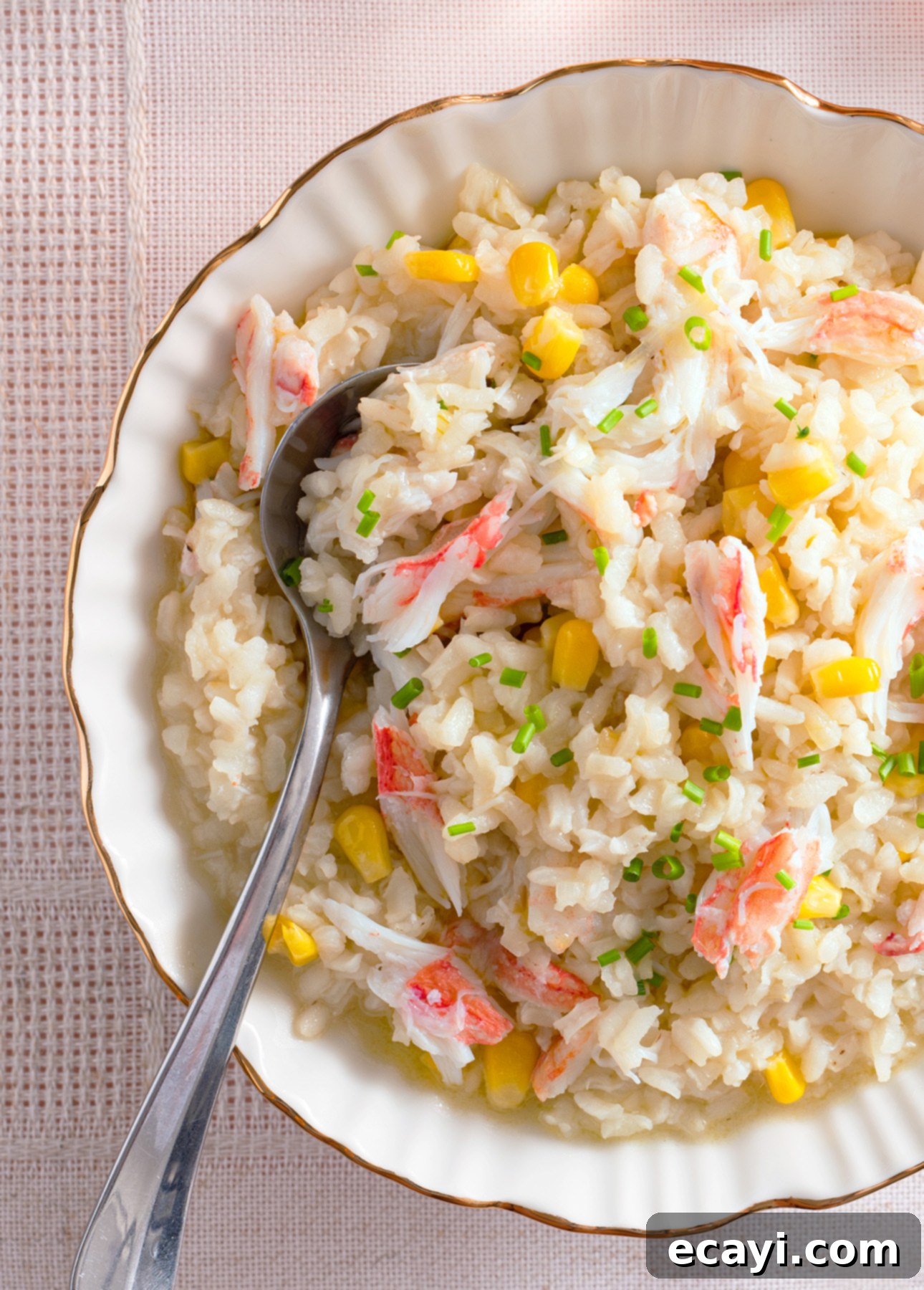Indulge in Luxury: The Ultimate Creamy Snow Crab and Fresh Corn Risotto Recipe
This luxurious crab risotto seamlessly blends the delicate sweetness of succulent snow crab meat with the vibrant freshness of corn, creating an exquisite and elegant dish that is guaranteed to captivate and impress your guests.
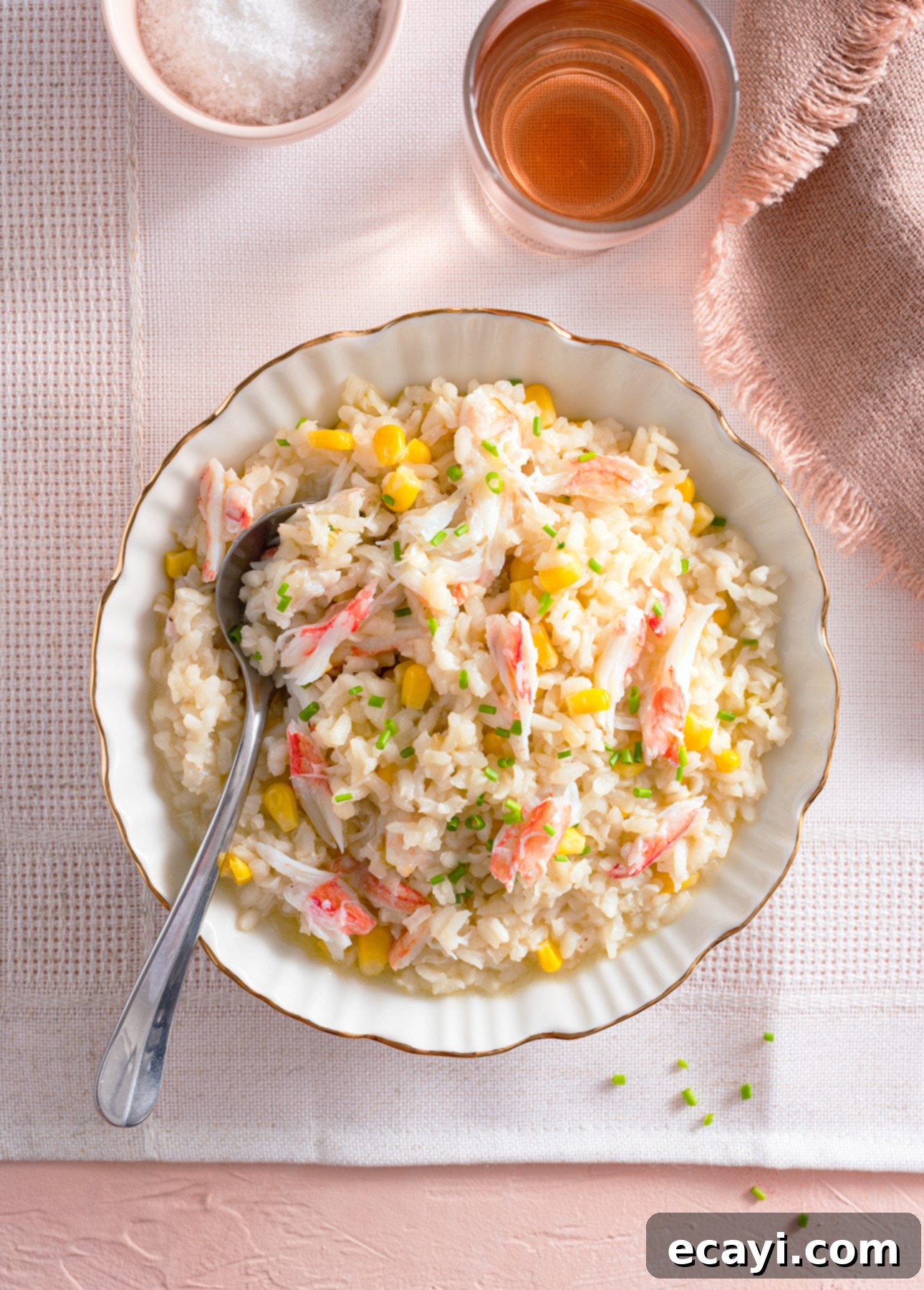
This post contains affiliate links. Full disclosure is at the bottom of the article.
Every year, as the chill of winter recedes and the promise of spring fills the air, a familiar excitement stirs within me. Beyond the longed-for return of warmer temperatures and brilliant sunshine, it’s the season of fresh, vibrant ingredients that truly ignites my culinary passions. Asparagus, tender green peas, tart rhubarb, and, perhaps most anticipated of all, the sweet, tender meat of snow crab make their grand reappearance.
Snow crab, a prized crustacean, thrives in the frigid, pristine waters of the northern oceans. Its vast habitat stretches from the rugged coasts of Newfoundland in Canada, across the icy expanse near Greenland, and all the way to the shores of Norway. These delicious creatures are also found abundantly in the Pacific Ocean, particularly around Alaska and in the depths of the Sea of Japan. Their widespread presence ensures a healthy, sustainable fishery, allowing us to enjoy this seasonal delicacy.
Here in Canada, where I live, snow crab fishing is a significant industry and a deeply cherished culinary event. As late March transitions into early April, the air buzzes with anticipation. Fishing companies eagerly announce the official start of snow crab season, and the public responds with an almost feverish enthusiasm. You’ll witness incredible scenes in my hometown: local fishmongers receive colossal mountains of freshly harvested snow crab legs, and these coveted treasures sell out in record time. It’s not uncommon to see eager customers queuing outside stores well before opening hours, all determined to secure their share for the annual snow crab party – a beloved tradition in many homes.
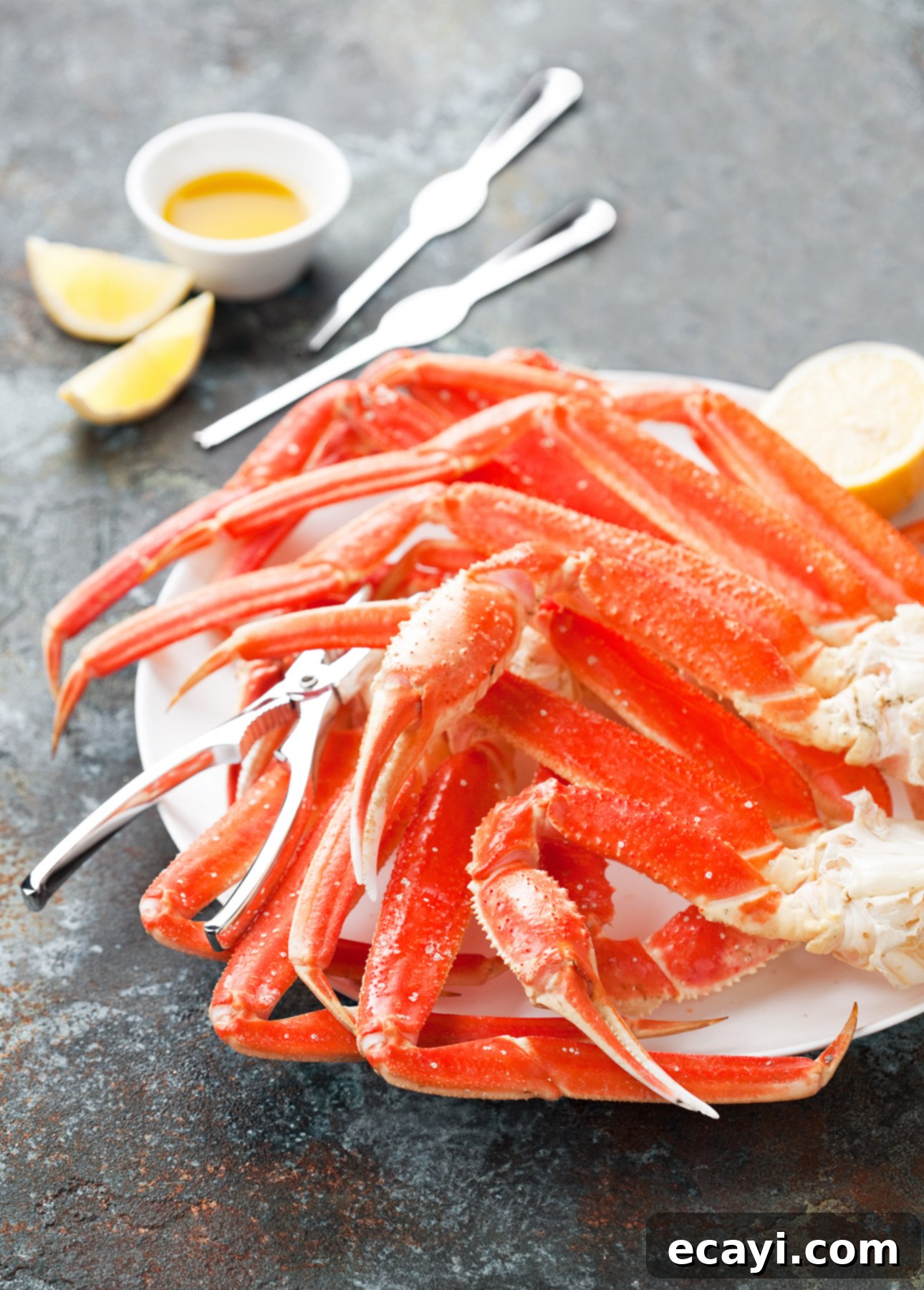
Given the brief, ephemeral nature of snow crab season, it’s truly essential to savor every moment and make the absolute most of this fleeting opportunity. At home, our first celebration of the season invariably involves a grand snow crab feast. Each guest delightedly dives into individual sections of crab legs, often enjoying them simply, with a light sprinkle of fresh lemon juice. The inherent sweetness and exquisite flavor of snow crab meat are so profound that they truly require little else in terms of seasoning. Yes, it can make for a gloriously messy dinner party, but the joy of cracking open those shells, extracting every last morsel of succulent meat, and experiencing its unparalleled taste is an integral part of the unforgettable fun and shared experience.
Once we’ve fully indulged our initial, primal craving for the pure taste of snow crab, my thoughts turn to creating more intricate and refined dishes. This is when I embark on making actual recipes that truly showcase this luxurious meat. Among my most treasured go-to preparations that honor the unique qualities of snow crab are delightfully crunchy crab cakes, rich and comforting seafood chowder, and of course, this elegant and sophisticated fresh corn and snow crab risotto. These recipes allow the crab to shine, transforming it into something truly special.
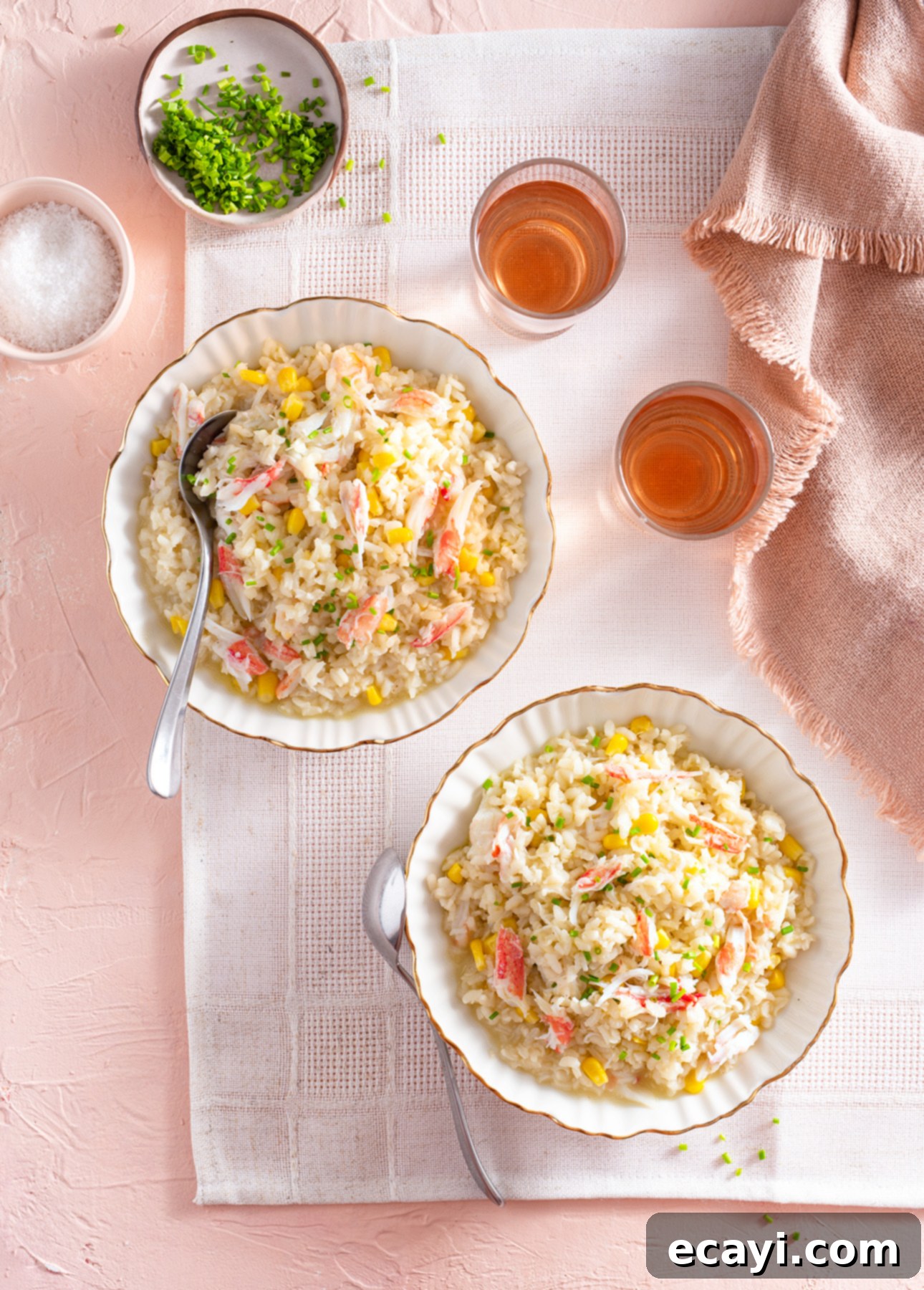
When incorporating snow crab meat into your cooking, a crucial principle to remember is to avoid overpowering its delicate, exquisite flavor with overly strong or assertive ingredients. The subtle nuances of the crab meat are easily lost if paired with aggressive seasonings. For this particular snow crab risotto, I meticulously select top-quality seafood stock, often sourced frozen from my trusted local fishmonger, as its gentle yet rich base complements the crab without dominating. Although this dish contains no cheese – a deliberate choice to preserve the crab’s integrity – it achieves a wonderfully creamy texture thanks to the natural starch released by the risotto rice as it cooks. The addition of fresh corn kernels not only introduces a delightful pop of vibrant color but also contributes a complementary sweetness that harmonizes beautifully with and further elevates the natural sweetness of the snow crab.
This decadent fresh corn and snow crab risotto stands as the quintessential dish for commemorating the precious snow crab season. It’s a culinary masterpiece that promises to impress your guests, leaving them with an unforgettable taste of spring’s finest offerings and a true sense of culinary indulgence.
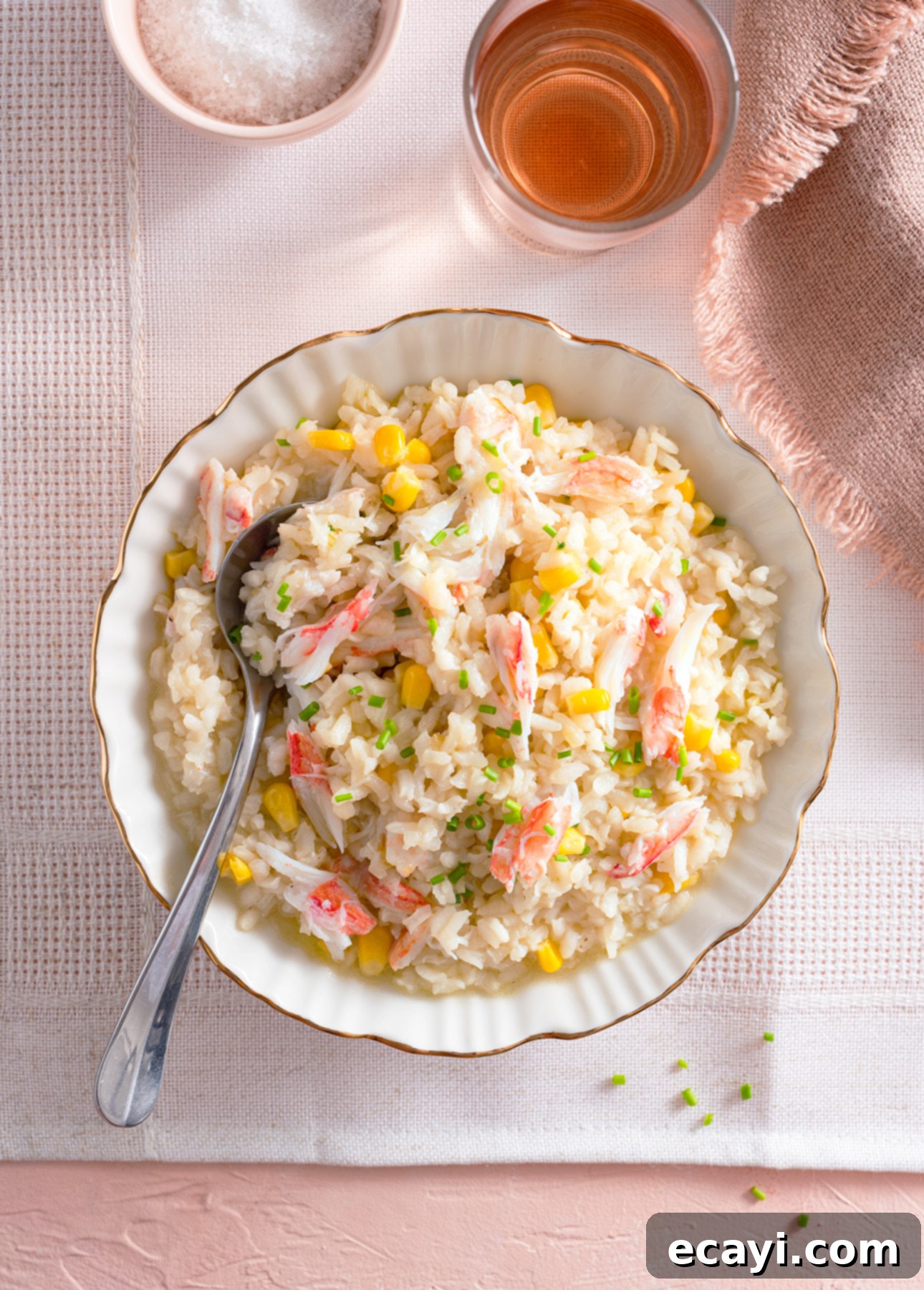
Helpful Tips for Crafting Your Perfect Snow Crab Risotto
My Golden Risotto-Making Rule: Superior Ingredients Create the Most Exceptional Risotto
As is so often the case with many dishes rooted in Italian culinary tradition, particularly those that appear simple on the surface, the quality of your ingredients profoundly impacts the final flavor and texture. This principle holds especially true for a delicate dish like snow crab risotto. By committing to using the very best ingredients you can possibly procure or afford, you’re setting the stage for a truly unforgettable meal.
Choosing the Right Crab Meat
For this exquisite crab risotto, the use of fresh crab meat is paramount. While fresh is always superior, if fresh snow crab isn’t available, high-quality frozen crab meat can be used, provided it’s handled correctly. It’s absolutely crucial to thaw frozen crab meat completely, ideally in the refrigerator for at least 24 hours, and then to press it thoroughly dry between layers of paper towels before incorporating it into the risotto. Crab meat, particularly after freezing, retains a significant amount of water. Failing to drain it properly will introduce excess moisture into your risotto, leading to a watery, undesirable consistency rather than the rich, creamy texture you desire.
The Importance of Quality Stock
When it comes to the stock for this crab risotto, I cannot emphasize enough the transformative power of homemade fish or seafood stock. Many reputable local fishmongers offer freshly made stock, often available in their freezer sections, which is an excellent alternative if making your own isn’t feasible. Homemade or artisanal stock imparts a wonderfully mild yet complex flavor profile to the risotto, acting as a supportive bass note that enhances the delicate crab without overshadowing it. In contrast, commercially canned fish or seafood stock frequently possesses a more assertive, sometimes metallic, flavor that can unfortunately steal the spotlight from your main ingredients. If your only option is canned stock, I strongly recommend diluting it at a ratio of two parts stock to one part water. This simple step will soften the flavors considerably, ensuring that the natural taste of the snow crab and corn remains center stage, as it should be.
Selecting the Ideal Risotto Rice
Finally, to achieve that signature creamy, luscious texture that defines a perfect risotto, the choice of rice is critical. Always opt for a high-quality risotto rice variety. Arborio, with its plump grains and high starch content, is a widely available and reliable choice. For an even creamier result and better bite, consider Carnaroli, often hailed as the “king of risotto rice” for its superior ability to absorb liquid without becoming mushy. Another excellent option is Vialone Nano, which produces a shorter, rounder grain with a velvety texture. Any of these varieties will ensure your risotto has that coveted, perfectly al dente, creamy consistency.
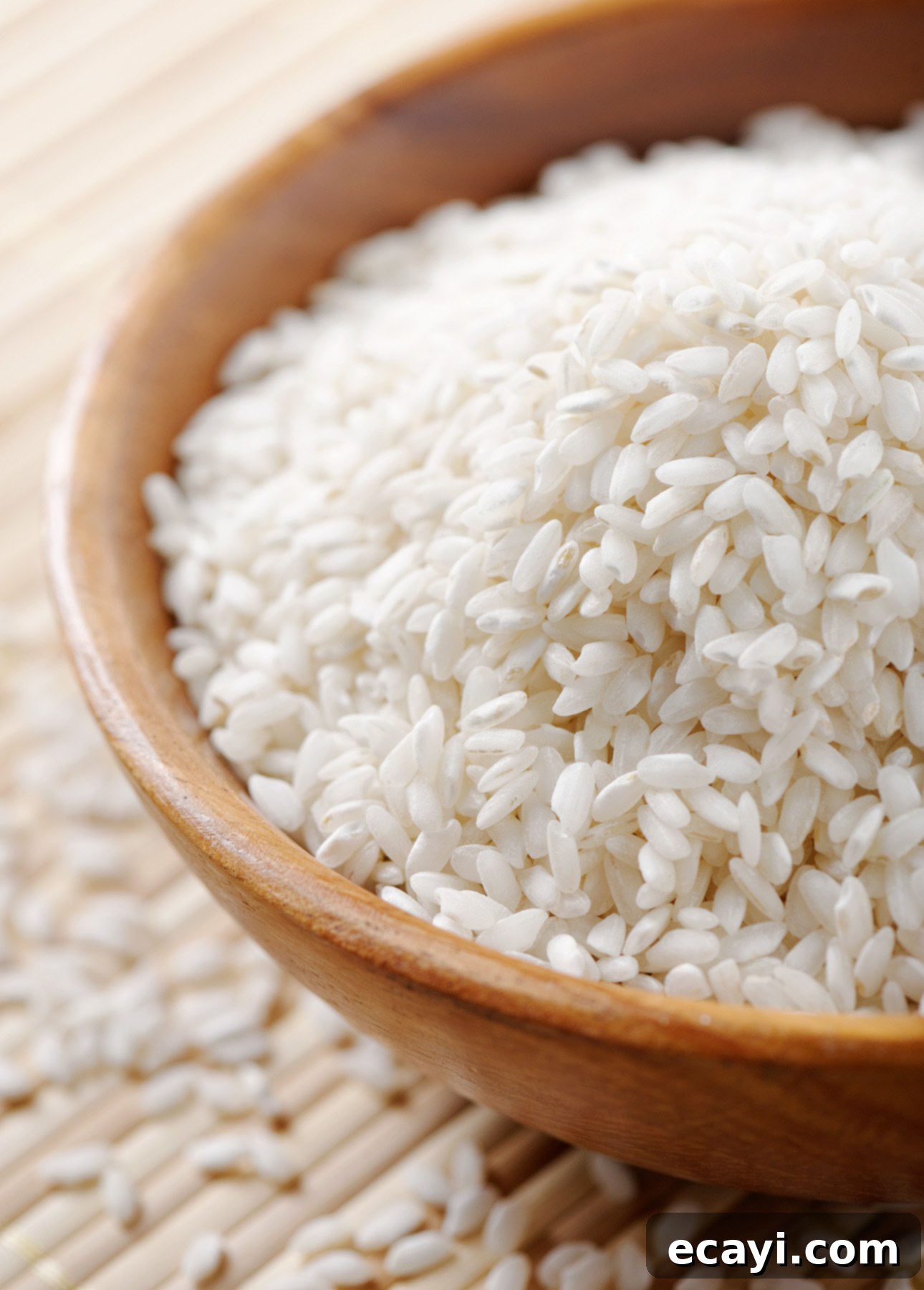
Using Cheese in Seafood Dishes: Yay or Nay?
In traditional Italian cuisine, there’s a strong, often fiercely held belief that cheese and seafood should never mix. For instance, in Italy, you would rarely, if ever, encounter cheese served over seafood pasta. While I personally hold a more flexible view and occasionally enjoy a touch of cheese in certain seafood preparations, such as in my saffron-infused shrimp risotto, when it comes to *this specific snow crab risotto*, I firmly believe that cheese is entirely unnecessary and, in fact, detrimental. The addition of an aromatic, robust cheese like Parmigiano-Reggiano or Pecorino-Romano would undeniably overwhelm the inherently subtle and delicate flavor of the sweet crab meat, completely obscuring its unique charm. This recipe is designed to allow the snow crab to be the star. It truly shines brightly on its own merits, delivering that iconic creamy texture we all love, thanks solely to the inherent starch within the risotto rice itself. Trust me, the natural creaminess and rich flavor achieved here need no additional dairy intervention.
Do I Need to Cook Live Snow Crabs to Make This Risotto?
While fresh, live snow crabs can sometimes be found in specialized markets, it’s far more common for snow crab clusters, or individual crab legs, to be sold either raw or already cooked, typically without the body. This convenience makes preparing crab dishes much more accessible for home cooks.
If you are fortunate enough to find super fresh, raw snow crab legs, cooking them yourself is a straightforward process. You can easily prepare them by boiling, steaming, or even grilling (though for risotto, boiling or steaming is preferred for easier meat extraction). This helpful video provides excellent demonstrations of various cooking methods, ensuring you can prepare your raw crab perfectly.
Opting to purchase fresh or frozen cooked snow crab legs, while slightly more expensive, offers significant convenience by eliminating the extra step of cooking the crab yourself. If you choose frozen cooked legs, simply thaw them overnight in the refrigerator. Once thawed, you can easily pick the sweet meat from the shells and gently stir it into your simmering risotto. This saves time and effort without compromising flavor.
A word of caution: while you might occasionally encounter frozen raw snow crab legs in some grocery stores or at certain fishmongers, I strongly advise against purchasing them, even if they appear to be a cheaper option. Uncooked crab meat undergoes a considerable deterioration in texture when subjected to freezing and thawing. This often results in a less pleasant, mushy texture, meaning that the recipes you painstakingly prepare with it simply won’t be as enjoyable or live up to their full potential.
How to Efficiently Remove Meat from Snow Crab Legs
When you’re indulging in a delightful plateful of whole crab legs at a feast, part of the joy is the leisurely process of cracking shells and meticulously picking out every succulent piece of meat. However, when you’re preparing a recipe that calls for picked crab meat, efficiency becomes key to shortening your overall prep time. There’s a smarter, quicker way to get that delicious meat out.
Here’s the most efficient method for extracting snow crab meat from its shells: Begin by separating each individual leg from the cluster. Next, break each leg into smaller, more manageable sections by snapping them apart at the joints. The shells of snow crabs are relatively thin and delicate, making this step quite easy. Now, take a sharp chef’s knife and carefully slice each section in half lengthwise. With the sections split open, the sweet meat is readily exposed, allowing you to easily pick it out with minimal effort and time. This technique significantly speeds up the process compared to traditional cracking.
Alternatively, you can also use sturdy kitchen shears to slice through the crab shells. Simply slice one side of each leg section lengthwise, then gently peel back the shell to reveal the pristine crab meat underneath. This method is incredibly effective and clean. This video provides a visual guide on how to master this technique, ensuring you can quickly and efficiently harvest all that delicious crab meat for your risotto.
Can’t Find Snow Crab Meat? Delicious Substitutions Are Available!
If fresh snow crab legs or picked snow crab meat prove difficult to find in your area, don’t despair! You have several excellent options for substituting other crab varieties that will still yield a truly delicious risotto.
Alaskan King Crab: A Robust Alternative
Alaskan king crab is arguably the closest substitute for snow crab in terms of its sweet flavor and appealing texture. While very similar, there are a few key differences to note: king crab legs are typically shorter and noticeably thicker than snow crab legs, and their shells are spiky and much more robust. Despite these physical distinctions, the meat offers a comparable luxurious experience.
Snow crab legs, displayed on the left, are generally thinner and possess a smoother appearance compared to the more robust and textured king crab legs, shown on the right.
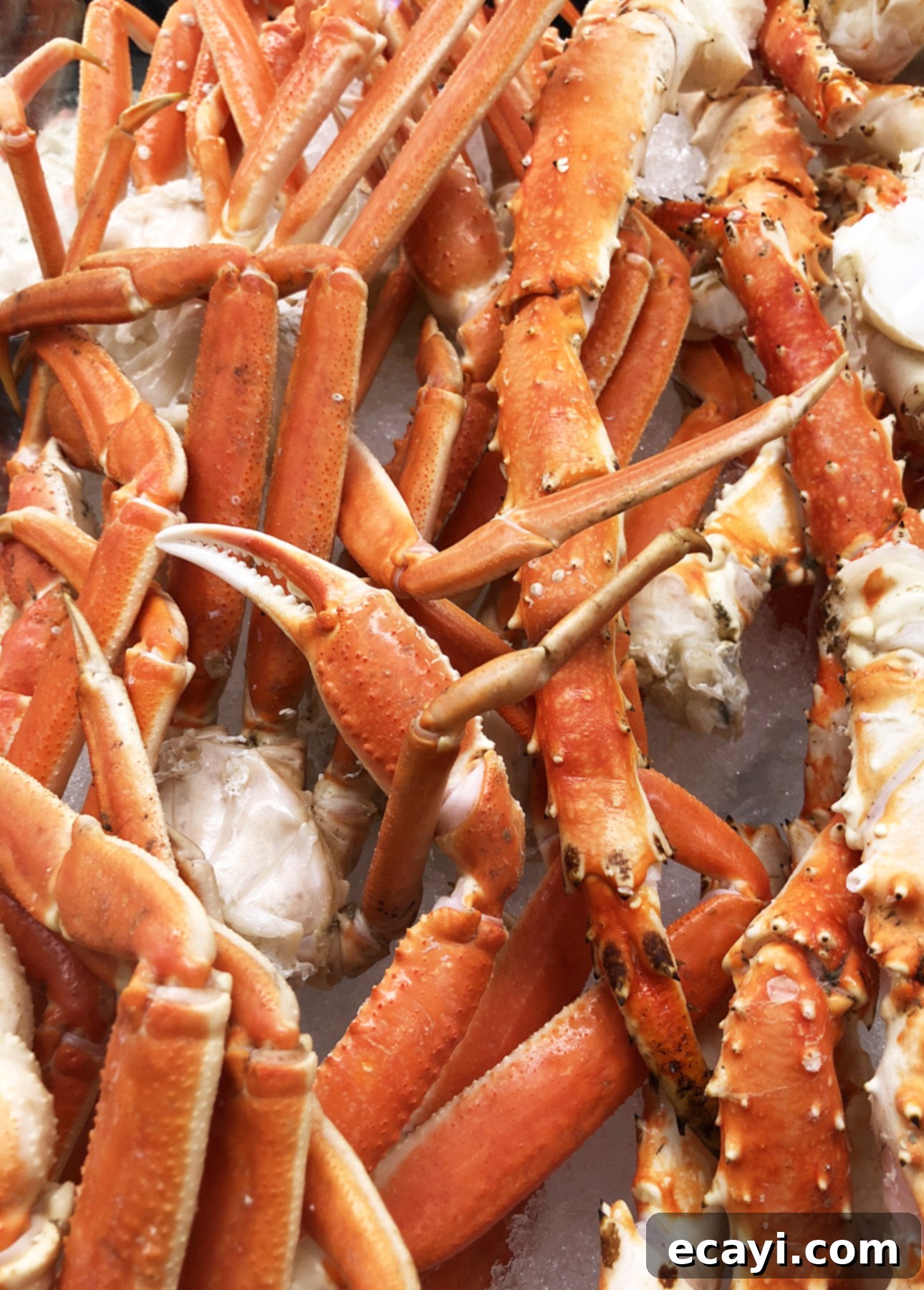
One notable advantage of king crab meat is its slightly more robust texture compared to snow crab, which means it withstands freezing significantly better. Because of this, blocks or cans of picked and frozen king crab meat are often quite easy to locate in many grocery stores or at local fishmongers. If you can get your hands on a high-quality frozen king crab product, I highly recommend it; it saves you the effort of cracking and picking the legs yourself. Simply thaw, drain away any excess moisture, and it’s ready to be incorporated into your risotto!
Quality Canned Crab Meat: A Convenient Option
Believe it or not, some companies produce canned crab meat of truly outstanding quality that can be a fantastic convenience for dishes like risotto. If you plan to use canned crab meat, always seek out “jumbo lump crab meat.” This designation indicates the highest quality, featuring large, intact pieces of meat with superior flavor and texture. Using jumbo lump will ensure your crab risotto retains that luxurious feel and exceptional taste.
A Crucial Warning: Avoid Imitation Crab!
Whatever you do, I implore you: never, under any circumstances, use imitation crab meat, often sold as crab-flavored pollock, in this delicate snow crab risotto. While imitation crab is perfectly fine and has its place in certain applications, such as a casual crab salad or inexpensive sushi rolls, its flavor and texture are simply not adequate for a refined and elegant dish like this risotto. It would fundamentally compromise the integrity and luxuriousness of the meal, resulting in a disappointing experience. Stick to real crab for real flavor!
How to Scale Up This Crab Risotto Recipe to Serve More Guests
Many risotto recipes are traditionally written to serve four to six people, often with ingredient quantities that can be cumbersome to halve or quarter. This has always been a point of frustration for me, as I frequently prepare risotto for just two individuals. To simplify things for home cooks, I purposefully design all my risotto recipes, including this one, to generously serve two. This approach makes the math incredibly straightforward if you wish to scale up the ingredients to accommodate four, six, or even more guests. It’s much easier to double or triple a recipe than to try to divide odd measurements.
Please note that this particular snow crab risotto recipe yields a very generous two-person serving. If you’re planning a more elaborate menu that includes appetizers and side dishes, you could comfortably stretch this recipe to serve three people without compromising on portion size or satisfaction. For larger gatherings, simply multiply the ingredients by two for four servings, or by three for six, adjusting the pan size as needed to allow the rice to cook evenly and the liquid to evaporate effectively. Enjoy the flexibility!
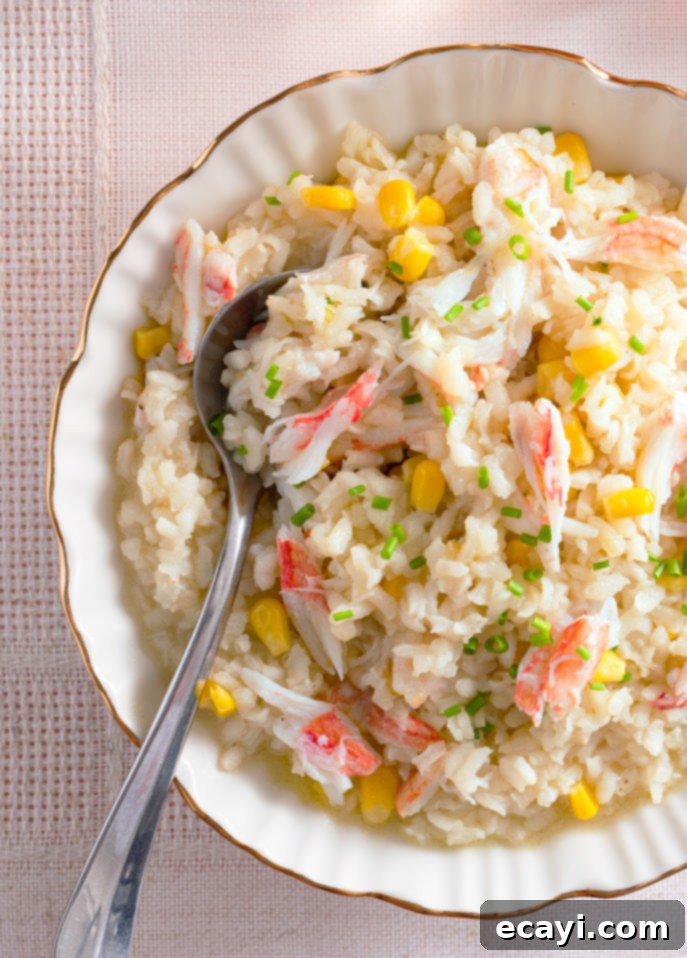
Pin Recipe
Fresh Corn and Snow Crab Risotto
Ingredients
- 2 ¾ cups fish or seafood stock (see note)
- 1 tbsp extra-virgin olive oil
- 1 tbsp butter
- 1 shallot, minced
- 5 oz risotto rice, such as Arborio, Carnaroli, or Vialone Nano
- 1 cup dry white wine, such as Pinot Grigio
- ½ cup fresh corn kernels (about 1 medium ear of corn), or frozen corn kernels
- Finely grated zest and juice from ½ lemon (about 1 tsp/5 ml zest and 2 tbsp/30 ml juice)
- 6 oz cooked snow crab meat
- Freshly ground black pepper
- Fleur de sel, or sea salt flakes
To Serve
- Extra-virgin olive oil
- Minced chives
Instructions
-
In a small saucepan, bring the stock to a simmer, then keep warm over low heat.
-
In a large saute pan or a cast-iron braiser set over medium-low heat, melt the butter in the olive oil. Add the shallot and cook, stirring, until soft, 3 to 4 minutes.
-
Add the risotto rice and stir for 2 minutes, until the grains are translucent around the edges. Add the wine and stir vigorously while the wine is bubbling up, scraping down the bottom of the pan to loosen the caramelized bits. Simmer until the wine is fully absorbed.
-
Add 1 ladleful of the stock and simmer, stirring from time to time, until the stock is almost completely absorbed.
-
Continue adding broth, one ladleful at a time, allowing each ladle to be absorbed before adding more. When there’s about 1 cup (250 ml) stock left, stir in the corn kernels and stir to incorporate. Add ½ cup (125 ml) broth, stir and keep cooking until the broth is almost fully absorbed.
-
Stir in the lemon zest and juice, lightly season the risotto with black pepper, taste, and season with salt if needed. Stir in the remaining broth, then gently stir in the snow crab meat to keep the lumps intact.
The risotto should now be loose and super creamy. Cover and turn off the heat. The risotto can stand for about 5 minutes but should be served as soon as possible for the best texture.
-
SERVING: Serve the crab risotto in warm bowls, then garnish each serving with a drizzle of flavorful extra-virgin olive oil and a sprinkle of minced chives.
-
STORAGE: This crab risotto is best enjoyed within minutes of being made. If you do have leftovers, refrigerate in an airtight container for up to 2 days. To reheat, transfer to a nonstick skillet, add a couple tablespoonfuls of broth or water and warm up over medium-low until the risotto is loose and hot. Serve immediately.
-
NOTE: Fish or seafood stock is perfect for fish or seafood-based risotto because its rich aromas underlines the flavors of the fresh produce from the sea.
The best fish and seafood stocks are frozen when freshly made: ask your local fishmonger, chances are they have some in the freezer.
You will also find seafood stock in the soup aisle, sold in tetrapaks, just as chicken stock is.
Did you make this?
Tell me how you liked it! Leave a comment or take a picture and tag it with @foodnouveau on Instagram.
This site is a participant in the Amazon Associates Program, an affiliate advertising program designed to provide a means for the site to earn fees by linking to Amazon and affiliated sites. If you click on an affiliate link, I may earn advertising or referral fees if you make a purchase through such links, at no extra cost to you. This helps me creating new content for the blog–so thank you! Learn more about advertising on this site by reading my Disclosure Policy.
